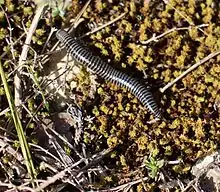Ommatoiulus sabulosus aimatopodus
Ommatoiulus sabulosus aimatopodus is a millipede occurring in the South of France; belonging to the same species than Ommatoiulus sabulosus, it differs from the type by the lack of lighter transversal lines on the back when adult. It is believed to be a Mediterranean-climate adapted variant, but whether it is a true subspecies or rather an ecomorph is unclear; first described by Antoine Risso as a distinct species, it is for now considered as a form of Ommatoiulus sabulosus, under the name Ommatoiulus sabulosus f. aimatopodus.[1]
| Ommatoiulus sabulosus aimatopodus | |
|---|---|
 | |
| Scientific classification | |
| Kingdom: | |
| Phylum: | |
| Subphylum: | |
| Class: | |
| Order: | |
| Family: | |
| Genus: | |
| Species: | |
| Subspecies: | O. s. aimatopodus |
| Trinomial name | |
| Ommatoiulus sabulosus aimatopodus (Risso, 1826) | |
| Synonyms | |
|
Julus aimatopodus Risso, 1826 | |

It has been shown that these millipede breed in autumn, and have shorter life cycle, compared to the northern Ommatoiulus sabulosus, that leads to the occurrence of only adults or old juveniles during the hot and dry summer season, believed to be an adaptation to that climate.[1]
References
- David, Jean-Francois; Coulis, Mathieu (2015). "Millipedes faced with drought: the life cycle of a Mediterranean population of Ommatoiulus sabulosus (Linnaeus) (Diplopoda, Julida, Julidae)". ZooKeys (510): 115–124. doi:10.3897/zookeys.510.8838. PMC 4523768. PMID 26257538.